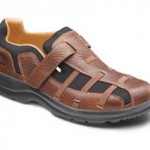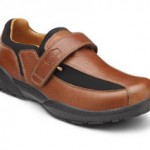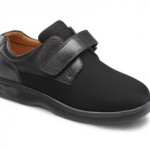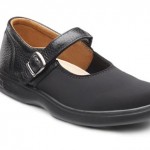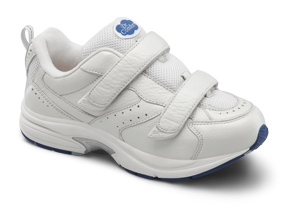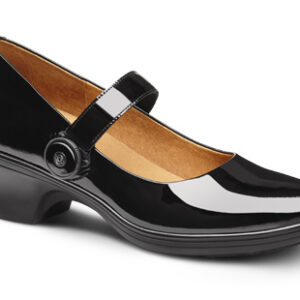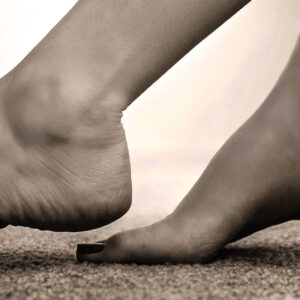Tips for Fitting Shoes
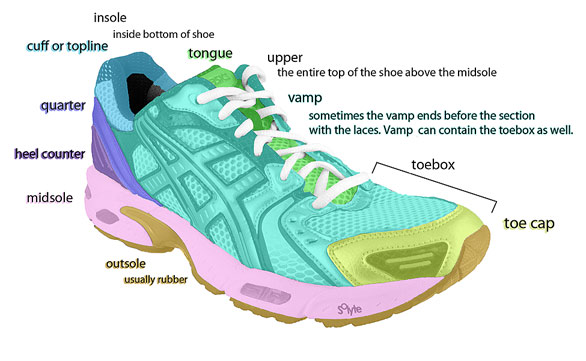
The Anatomy of a Shoe
Fitting Shoes to Normal Feet
When fitting shoes to feet with no significant deformity, the process is fairly straightforward. Shoes are constructed around a last: lasts are foot-like structures designed to maintain the form of the shoe while the upper is sown to the sole of the shoe. This dictates the bias of the shoe. Some shoe companies design their uppers around a high arched (supinated or pes cavus) foot last while others will be designed around a moderate (neutral) last.
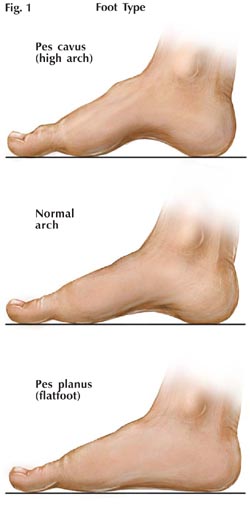
Foot Types Based on Arch
Fitting Shoes to the High Arched Foot
People with a supinated foot will gravitate to shoes constructed around the supinated last. The supinated foot type has a high arch by nature, this changes the overall structure of the foot by bringing the toes closer to the mid-line of the body. It is important to note: trying to create a higher arch with a shoe shoe is not recommended; this will usually create pressure areas on the toes or foot. It is a better idea to incorporate a custom orthotic or a recommended firm pre-fabricated orthotic for this purpose.
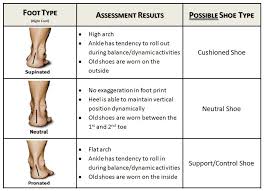
Foot types with a description
Fitting Shoes to Flat Feet
Flat feet and the neural foot are easier to deal with when it comes to fitting shoes. Most shoe companies construct their uppers around a neutral last. People with flat feet or feet with excessive pronation at anytime during the gait cycle need to consider custom orthotics. Many people have feet that pronate as the heel comes off the ground during the propulsive (push off) phase of the gait cycle. This motion causes a wringing-like effect on the plantar fascial band, this can cause plantar fasciitis. Excessive pronation needs to be controlled with orthotics that fit the person. Yes, some pre-fabricated insoles will work for some individuals. We all have very different feet; they may appear similar on the surface but different degrees of flexibility, internal structure, and muscle tone can make a difference regarding how an orthotic will function.
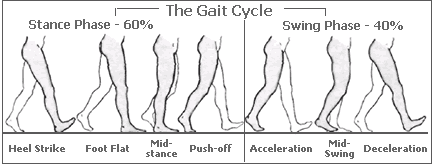
Gait cycle
Fitting Shoes to Feet with Swelling (Edema) in the Feet
Edema or swelling of the feet is a common problem for some people. Some types of edema fluctuate regularly, while others are consistently swollen. Edema can be very dramatic for some, while others only have very mild edema. Mild cases of edema may not require additional space when fitting shoes. People with severe edema should consider one of our men’s or women’s double depth shoes, these shoes have an additional 1/2 inch of depth built into the shoe.
If one foot has more edema than the other or the swelling fluctuates spacers can be used to snug the shoe to the foot. The spacers slip under the insert of the shoe to reduce available space. It is important when fitting shoes to fit the larger foot; if one foot has more swelling than the other, fit the larger foot and use spacers to help the other shoe fit comfortably. Some shoes like our Betty in our Women’s Casual Collection and Douglas in our Men’s Casual Collection offer some natural expansion for mild to moderate edema.
- This lightweight leather and Lycra sandal accommodates mild to moderate swelling.
- Lightweight leather and Lycra with a Velcro strap. Accommodates most mild to moderate edema.
Fitting Shoes to feet with Bunions and Hammer Toes
Shoes with large bony prominences can be very challenging when fitting shoes. Some shoes are built for such feet. The Brian and Brian X in the men’s casual collection and the Annie, Annie X, and Merry Jane Lycra have an upper made from Lycra. Lycra is a very durable stretchy material. The stretchy nature of Lycra easily accommodates most bunions, hammer toes and other deformities.
- Annie ultra soft Lycra offers a very stretchy material capable of accommodating almost any deformity
- The Mary Jane Lycra offers the same stylish look as the other Mary Jane’s, yet it can accommodate hammer toes and bunions much better
Tips for Sizing Shoes
Do the shoes actually fit? This can depend on the intended use of the shoes. Some people wear shoes to protect their feet by minimizing pressure and/or the effects of the outside world, while others need support and other qualities while cresting 14ers.
There are three measurements to take into consideration when measuring the size of your feet; the over all length, width, and the length and the arch. These measurements are done with a Branock Device and each play a role in properly fitting a shoe.
When a foot becomes weight bearing the foot splays as it attempts to balance and stabilize the weight of the body. It is in this position that a shoe should fit the foot. When fitting shoes you should always stand and check the position of the foot to see if it fits. In most cases there should be at least a 1/4″ of space from the tip of the toe to the tip of the shoe. Some runner, climbers, and sprinters prefer a skin tight fit, for increased feel and minimal weight.
The arch is measured from the back of the heel to the center of the first metatarsal’s head with the sliding piece on the big toe side of the Brannock Device. This is the bone prominence just behind where the big toe is able to move up and down. This measurement determines the flex point of the foot and tries to match it with a flex point in a shoe. To find the flex point in a shoe: Hold the heel in one hand and the toe box in the other then compress the shoe. Why is this important? Some people have short toes and others have long toes, and the flex point of the shoe should fit the flex point of the feet, but not at the expense of the toes. If a person has an overall length of 7 and an arch of an 8 the person shoe wear an 8, and enjoy the extra wiggle room in the toe box. An individual with a shoe size of 8 and an arch size of 7 will need to wear an 8. Always size to the larger number when fitting shoes.
The width of the foot is pretty straightforward; however, the conversion of old methods to more current nomenclature has simplified the process. Narrow, Medium, Wide, and Extra Wide is much easier than eeee, b, etc. For many of the patients I see in my office it seems there was a competition to see who could have the most narrow foot or at least cram their foot into the most narrow shoe. The width needs to be measured while the foot is bearing all of the body’s weight, the arch slider should be in place, and then the width slider should barely touch the skin on the outside of the foot. The width is then correlated with the overall length and arch measurement the smallest number is used to determine the width.
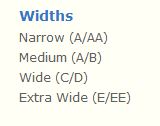
Common Shoe Width Chart
Now try different brands and sizes of each, they all fit a little differently, see which one feels the best while you walk or run.
Other factors and recommendations when fitting shoes
- Look for shoes that offer removable insoles,
- Do not look to shoes for arch support. That is what orthotics are for.
- When using custom functional orthotics or our recommended pre-fabricated orthotics, put them under the insole of the shoe and take them with you so you can try them in any new shoes you may purchase.
- A shoe should grip and steady the foot across the mid-foot area, when fitting shoes or hiking boots make sure they grip your foot and snug it to your orthotics– your toes should be able to wiggle with out being restricted by the top of the toe box.
- Allow for changes in your feet; if you have a tendency for swelling /edema make sure you can accommodate the changes with spacers or expanding shoes.

